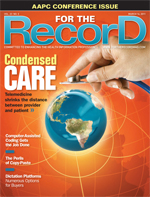 March 14, 2011
March 14, 2011
Coding for Dysphagia
By Audrey Howard
For The Record
Vol. 23 No. 5 P. 27
Dysphagia constitutes a difficulty in swallowing, which may also be associated with pain. Occasionally, a patient may not be able to swallow at all. Although dysphagia can occur at any age, it is more common in older adults.
Dysphagia alone may not be of concern, but it may be indicative of a more serious condition requiring treatment if it persists or is severe. In addition, the condition may make it difficult for a patient to consume enough calories or fluids, which can lead to additional medical problems.
The condition is classified to ICD-9-CM subcategory 787.2, with a fifth-digit subclassification required as follows:
• 787.20, Dysphagia, unspecified (includes difficulty in swallowing, not otherwise specified);
• 787.21, Dysphagia, oral phase;
• 787.22, Dysphagia, oropharyngeal phase;
• 787.23, Dysphagia, pharyngeal phase;
• 787.24, Dysphagia, pharyngoesophageal phase; and
• 787.29, Other dysphagia, which includes cervical dysphagia and neurogenic dysphagia.
The specific code assignment depends on where the dysphagia occurs in the swallowing process. Oral phase dysphagia (787.21) refers to a problem with moving food from the mouth to the oropharynx. Oropharyngeal phase dysphagia (787.22) refers to problems with moving food from the oropharynx into the esophagus. Pharyngeal phase dysphagia (787.23) results from a weakness or lack of coordination of the pharyngeal muscles; aspiration is most likely to occur in this phase. Pharyngoesophageal phase dysphagia (787.24) results from passing food into the esophagus.
If the dysphagia is due to a prior stroke, then code 438.82, Dysphagia as late effect of cerebrovascular disease, is assigned and sequenced first followed by a code for the specific type of dysphagia (787.20 to 787.29).
Dysphagia documented as functional, hysterical, or nervous is classified to code 300.11, Conversion disorder. Psychogenic dysphagia is assigned to code 306.4, Gastrointestinal malfunction arising from mental factors.
Since dysphagia is a symptom, it will not be sequenced as the principal diagnosis if the underlying cause has been documented by the physician. However, the appropriate code for dysphagia may be coded and sequenced as a secondary diagnosis if it is not inherent to the disease process.
Symptoms
The following signs and symptoms are often associated with dysphagia:
• pain while swallowing (odynophagia);
• inability to swallow;
• sensation of food stuck in throat or chest;
• drooling;
• hoarseness;
• regurgitation;
• frequent heartburn;
• food or stomach acid backing up into throat;
• unexpected weight loss; and
• coughing, choking, or gagging while swallowing.
Causes
The following are some common causes of oropharyngeal dysphagia:
• postpolio syndrome (138);
• multiple sclerosis (340);
• muscular dystrophy (category 359);
• Parkinson’s disease (332.0);
• cerebral palsy (category 343);
• stroke (categories 430 to 434);
• brain or spinal cord injuries; and
• esophageal diverticulum or Zenker’s diverticulum (530.6).
Common causes of esophageal dysphagia are as follows:
• achalasia (530.0);
• esophageal spasm (530.5);
• esophageal stricture (530.3);
• esophageal tumors;
• gastroesophageal reflux disease (530.81);
• eosinophilic esophagitis (530.13); and
• systemic sclerosis (710.1).
Complications
Dysphagia can lead to the following complications:
• malnutrition (categories 260 to 263);
• dehydration (276.51); and
• aspiration pneumonia (507.0).
Diagnosis
To diagnose the underlying cause of the dysphagia, a physician may perform any of the following tests:
• barium swallow or modified barium swallow;
• endoscopy such as laryngoscopy or esophagoscopy;
• endoscopic swallowing evaluation;
• esophageal manometry; and
• esophageal muscle test.
Treatment
Treatment for dysphagia mainly depends on the type or the underlying cause. For oropharyngeal dysphagia, a speech therapist may teach a patient exercises to coordinate the swallowing muscles or teach swallowing techniques. Treatment for esophageal dysphagia may include esophageal dilation, surgery to remove esophageal tumor or diverticulum, or medication.
Severe dysphagia may require the insertion of a feeding tube (96.6) or a percutaneous endoscopic gastrostomy tube (43.11).
Coding and sequencing for dysphagia are dependent on the physician documentation in the medical record and application of the Official Coding Guidelines for inpatient care. Also, use specific AHA Coding Clinic for ICD-9-CM and American Medical Association CPT Assistant references to ensure complete and accurate coding.
— This information was prepared by Audrey Howard, RHIA, of 3M Consulting Services. 3M Consulting Services is a business of 3M Health Information Systems, a supplier of coding and classification systems to more than 5,000 healthcare providers. The company and its representatives do not assume any responsibility for reimbursement decisions or claims denials made by providers or payers as the result of the misuse of this coding information. More information about 3M Health Information Systems is available at www.3mhis.com or by calling 800-367-2447.
Coding for Dysphagia in ICD-10-CM
Dysphagia is classified to ICD-10-CM subcategory R13.1, with a fifth character required as follows:
• R13.10, Dysphagia, unspecified (includes difficulty in swallowing, not otherwise specified);
• R13.11, Dysphagia, oral phase;
• R13.12, Dysphagia, oropharyngeal phase;
• R13.13, Dysphagia, pharyngeal phase;
• R13.14, Dysphagia, pharyngoesophageal phase; and
• R13.19, Other dysphagia, which includes cervical dysphagia and neurogenic dysphagia.
If the dysphagia is due to a prior stroke, then an appropriate code from category I69, Sequelae of cerebrovascular disease, with the final characters -91 is assigned and sequenced first followed by a code for the specific type of dysphagia (R13.10 to R13.19). For example, oropharyngeal dysphagia due to nontraumatic intracerebral hemorrhage is assigned to codes I69.191 and R13.12.
Dysphagia documented as functional, hysterical, nervous, or psychogenic is classified to code F45.8, Other somatoform disorders.
The coding guidelines for symptoms are the same in ICD-10-CM as they are in ICD-9-CM. In other words, a symptom code should not be sequenced as the principal diagnosis when a related definitive diagnosis has been established. Since dysphagia is a symptom, it will not be sequenced as the principal diagnosis if the underlying cause has been documented by the physician.
— Audrey Howard



